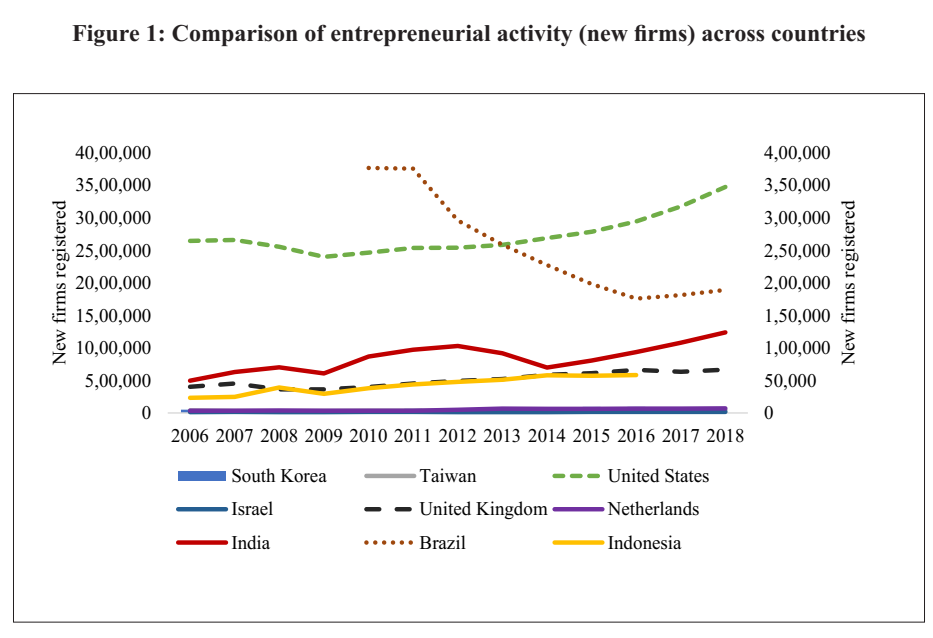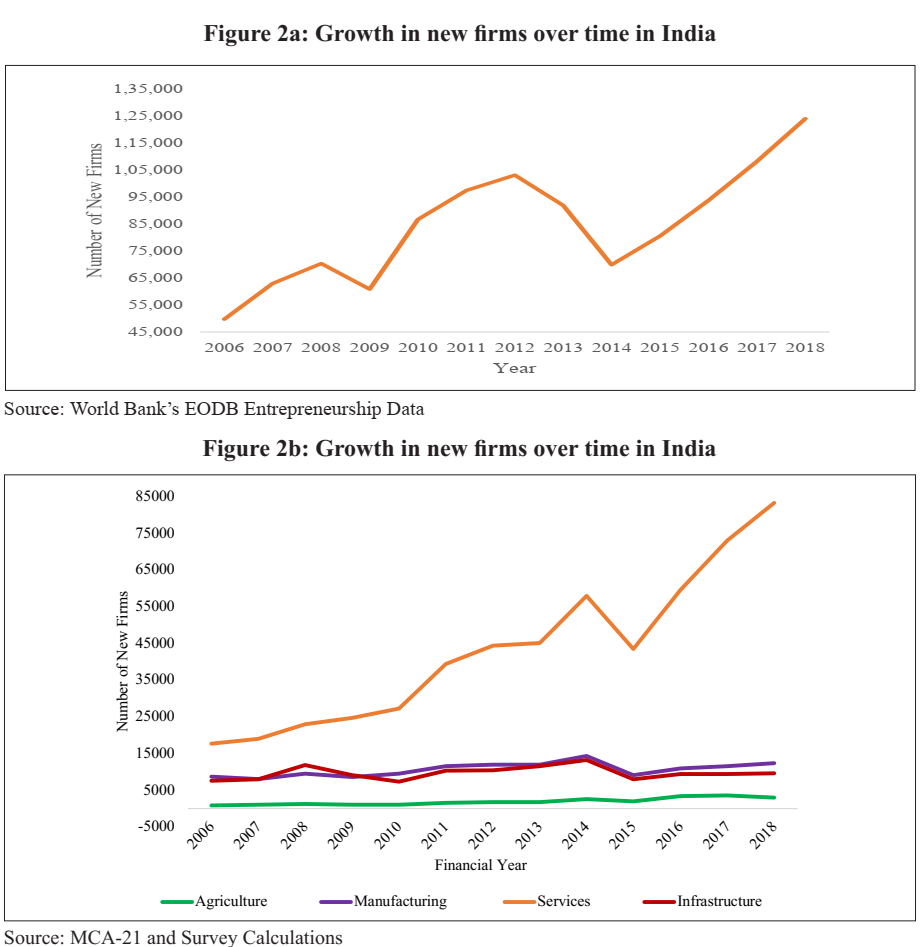The “Startup India” campaign of the Government of India recognizes entrepreneurship as an increasingly important strategy to fuel productivity growth and wealth creation in India.
Chapter Focus: Content and drivers of entrepreneurial activity at the bottom of the administrative pyramid – over 500 districts in India.
- India ranks third in the number of new firms created.

- Data shows that new firm creation has gone up dramatically in India since 2014.
- New firm creation in services is significantly higher than that in manufacturing, infrastructure or agriculture.

Entrepreneurship is measured as the count of new firms in the Ministry of Corporate Affairs (MCA) – 21 database, a public dataset that provides a one-time snapshot of all active firms registered with the Ministry of Corporate Affairs (MCA) between 1990 and 2018
- Entrepreneurship
at the bottom of the administrative pyramid – a district – has a
significant impact on wealth creation at the grassroots level.
- Birth of new firms is very heterogeneous across Indian districts and across sectors.
- Literacy and education in the district foster local entrepreneurship significantly.
- The eastern part of India has the lowest literacy rate of about 59.6 per cent according to the census of 2011. This is also the region in which new firm formation is the lowest.
- The level of local education and the quality of physical infrastructure in the district influence new firm creation significantly.
- Ease of Doing Business and flexible labour regulation enable new firm creation, especially in the manufacturing sector.
Entrepreneurship and GDP
- Entrepreneurs are seen as agents of change that accelerate innovation in the economy.
- On a per-capita basis, India has low rates of entrepreneurship in the formal economy.
- A large number of India’s enterprises operate in the informal economy which is not captured in these data.
- Though the peninsular states dominate entry of new firms, entrepreneurship is dispersed across India and is not restricted just to a few metropolitan cities.
Spatial Heterogeneity in Entrepreneurial Activity
- The impact of new firm entry is greatest in the Manufacturing and Services sectors.
- All regions demonstrate strong growth in entrepreneurial activity over time with the exception of the eastern states.
- The agriculture sector is not geographically localized and seems to be distributed evenly across most districts in India.
- States in the highest quintile of relative entrepreneurial activity in the Agriculture sector are Manipur, Meghalaya, Madhya Pradesh, Assam, Tripura, and Orissa.
- North-Eastern states are more likely to be private enterprises in the food business such as organic produce farms and tea plantations.
- The majority of the establishments in Madhya Pradesh and Orissa are farmer producer companies.
- The manufacturing sector is highest in the regions of Gujarat, Meghalaya, Puducherry, Punjab and Rajasthan.
- States with inflexible labour laws such as West Bengal, Assam, Jharkhand, Kerala, and Bihar were classified in the lowest quintiles of entrepreneurial activity.
- Gujarat’s labour reforms are viewed as pro-worker.
- Entrepreneurial activity in the Infrastructure sector is highest in the states of Jharkhand, Arunachal Pradesh,
- Himachal Pradesh, Mizoram, Jammu and Kashmir, and Bihar have been characterized by poor levels of extant infrastructure.
Determinants of Entrepreneurial Activity
The focus is on two key sets of district-level attributes that drive the level of entrepreneurial activity in the district
- Social infrastructure: Social infrastructure in a district largely relates to the general education levels in the district. Higher education levels in a district enable the development of better human capital that relates to an increased supply of ideas and entrepreneurs. Higher education also increases the supply of talent available to entrepreneurs for managing and growing their companies.
- Physical infrastructure: It includes access to basic physical infrastructure in the district as well as physical connectivity that captures across-district infrastructure in most cases. The access to physical infrastructure in a district is measured using the proportion of villages in a district that is connected by tar roads and it correlates with access to other public goods like electricity, water/ sanitation facilities, and telecom services, which are fundamental to all businesses.
However, a rich body of prior work also emphasizes the role of other spatial and industrial factors in driving heterogeneity in entrepreneurial activity. These include
- population attributes: population size and density — market size, competition
- other district-level conditions: digital literacy, ease of access to technology and finance
- regulatory framework : Taxes, compliance costs etc
- agglomeration economies: input/output relationship between the firms
These factors influence opportunities, skills and resources available to entrepreneurs, driving firm creation and growth
MCQs
- As per the latest Economic Survey, entrepreneurial activity in the Infrastructure sector is highest in the regions of
1- Jharkhand
2- Arunachal Pradesh
3- Himachal Pradesh
Select the correct answer using the codes given below.
A. 1 only
B. 1 and 2 only
C. 2 and 3 only
D. 1, 2, and 3
Ans. (D) The entrepreneurial activity in the Infrastructure sector is highest in the states of Jharkhand, Arunachal Pradesh, Himachal Pradesh, Mizoram, Jammu and Kashmir and Bihar, some of which are characterized by poor levels of extant infrastructure.
Not surprisingly, new firms in these states are largely engaged in construction, logistics and transport, utility generation, transmission and distribution, alternative energy distribution, and Infratech. - As per the latest Economic Survey, entrepreneurial activity in the Manufacturing sector is highest in the regions of
1- Gujarat
2- Meghalaya
3- Puducherry
4- Rajasthan
5- Punjab
Select the correct answer using the codes given below.
A. 1, 2, and 3 only
B. 2, 3, 4, and 5 only
C. 1 only
D. 1, 2, 3, 4, and 5
Ans. (D) The entrepreneurial activity in the Manufacturing sector is highest in the regions of Gujarat, Meghalaya, Puducherry, Punjab and Rajasthan. Within Gujarat, the most entrepreneurially active districts in the Manufacturing sector are Surendranagar, Rajkot, Bhavnagar and Surat.
Establishments in these regions are focused on textiles, chemicals, metals, plastics, and pharmaceuticals manufacturing. The nature of establishments in each of these regions attests to agglomeration economies documented by prior research in the Indian manufacturing sector.





